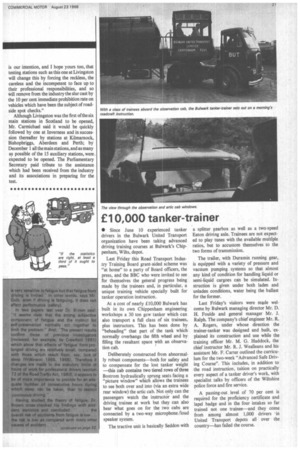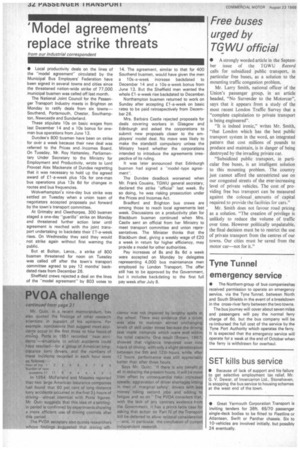PVOA challenges basis of hours cuts
Page 22

Page 23

Page 34

If you've noticed an error in this article please click here to report it so we can fix it.
• The Passenger Vehicle Operators Association is now so convinced that the Ministry of Transport's proposed cuts in driving hours have no road safety evidence to support them that it is asking for the status quo to be preserved until researchers in this field have finished their present studies and are able to report. This may be within a year or two and the PVOA hopes that the Ministry might be prepared to postpone any reduction in legal driving hours until the reports are to hand. The Association is convinced that all available evidence points to the conclusion that fatigue is a minimal factor--if indeed it has any practical effect—in road accident causation.
In pursuing evidence on the effect of fatigue, the PVOA would like to have a basis of co-oPeration with the Medical Research Council, and part of the money which the PVOA is seeking from private operators to oppose the hours cuts could well be devoted to research projects in this field. The Association has recently written to Britain's 4,000 independent operators -including many who are not members of the PVOA asking for contributions to the fund. Response so far has been very encouraging—some operators giving more than asked for
Already the Association's secretary, Mr. I/ R. Quin, has made a wide-ranging investigation into research on fatigue and driving. The material which he has discovered so far, reinforces his view that far from linking accident-proneness with length of time at the wheel fat least, within the current legal maximum hours/ the researches show an almost opposite relationship. His conclusion is that the Ministry has no objective factual evidence on a road safety basis for reducing hours and that the proposals in the Transport Bill are in reality social provisions. and therefore are not properly within the scope of
transport legislation.
Mr. Quin points out that the Road Resear Laboratory (whose experiments the Minist is, as a matter of policy, adducing in sup of some other measures or proposals) h done no work in the fatigue field since 196 when A. Crawford BSc, PhD, prepared critical review of research on fatigue an driving. But, says Mr. Quin, the Medic Research Couricil has continued regular stu of the problem and will shortly decide wh to develop its studies or leave the subj the RFIL. At the M RC, I. D. Brown, BSc, CEng. WEE, has conducted studies about 1960 and must, says Mr. Gum, n the leading authority in this country.
Both Or. Crawford and Dr. Brown, thou aware of experiments indicating certain physical reactions to driving, concluded that fatigue was not an important accident factor Both wished to see continuing research. Dr. Crawford's conclusion was: -There are therefore two aspects to driving and fatigue. First, it must be asked whether, arid to what extent driving leads to fatigue and secondly, how much fatigue affects driving. It is entirely possible that driving creates a great deal of fatigue, but fortunately is not very sensitive to it—or conversely that driving performance is very sensitive to fatigue but that fatigue frori driving is limited '' In other words, says Mrig, Quin, even if driving is fatiguing, it does nof affect performance (safety).
In two papers last year Dr. Brown said '
"It seems clear that the strong subjective component of fatigue and the instinct fat self-preservation normally act together to limit the problem." And: "The present resultitk, confirm those of previous inve8tigaton*1 (reviewed, for example, by Crawford 196 which show that effects of 'fatigue' from pr longed driving are relatively small, compar with those which result from, say, lack sleep (Wilkinson 1965, 1966). Therefore if , ichanges are made in the statutory limits of 'hours of work for professional drivers (section 73 of the Road Traffic Act, 1960). it appears to be of more importance to provide for an a lquate number of consecutive hours duri which sleep can be taken, than to restrf continuous driving "
Having studied the theory of fatigue. Dr_
rown cross-checked his findings with ac 'dent statistics and concluded: " . . .overall risk of accidents from fatigue is low. ,the risk is low as compared with many othe0 Mises of accident . . " Mr. Quin in a recent memorandum, has also quoted the findings of other lesea,ch scientists in support of his opinions_ For
example. conclusions that suggest most accidents occur in the first three to four hours of driving Potts in 1951 recorded "near accidents'"--situations in which accidents could have resulted— -for a group of American longdistance lorry drivers. and the numbers of these incidents recorded in each hour were as follows:
Hour 0 no 1 2 3 4 6 6 7 8 9 Nionber of ncar accidents 11 11 6 4 4 4 4 3
In 1954. McFarland and Moseley reported that two large American insurance companies had found that 60 per cent of long-distance lorry accidents occurred in the first 3+ hours of drivingalmost identical with Potts' figures. Mr. Quin suggests that this idea of a settling' in period is confirmed by experiments showing a more efficient use of driving controls after this period.
The PVOA secretary also quotes researchers whose findings suggested that driving effi ciency was not impaired by lengthy spells at the wheel. There was evidence that a ariver was able to maintain almost unchanging levels of skill under stress because the driving task made demands which were well within his total capacity' One result (Brown, 1967) showed that vigilance improved over nine hours of driving, with only a slight deterioration between the 9th and 12th hours, while. after 12 hours. performance was still appreciably better than after three hours
Says Mr. Quin: "If there is any benefit at all in reducing the present hours, it will he more than offset by consequential risks: increased speeds: aggravation of driver shortages letting in men of 'marginal safety', drivers with less money taking second jobs and adding to fatigue and so on "The PVOA considers that, with the lack of any contrary evidence from the Government, it has a prima facie case for asking that action on Part IV of the Transport sill be deferred to allow rational consideration and in particular, the conclusion of current independent research




















































































































